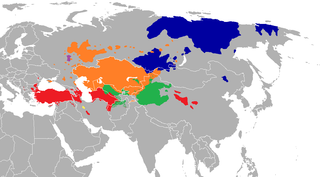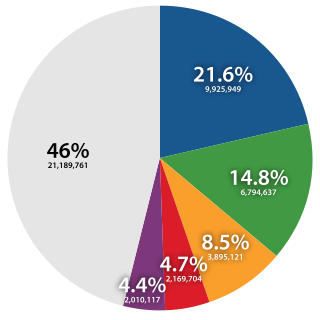Related Research Articles

Altaic is a Sprachbund or proposed language family that would include the Turkic, Mongolian and Tungusic language families and possibly also the Japonic and Koreanic languages. Speakers of these languages are currently scattered over most of Asia north of 35 °N and in some eastern parts of Europe, extending in longitude from Turkey to Japan. The group is named after the Altai mountain range in the center of Asia. The hypothetical language family has long been rejected by most comparative linguists, but still has some supporters.

Korean is an East Asian language spoken by about 77 million people. It is the official and national language of both Koreas: North Korea and South Korea, with different standardized official forms used in each country. It is a recognised minority language in the Yanbian Korean Autonomous Prefecture and Changbai Korean Autonomous County of Jilin Province, China. It is also spoken in parts of Sakhalin, Russia and Central Asia.

The Turkic languages are a language family of at least 35 documented languages, spoken by the Turkic peoples of Eurasia from Southern Europe, Eastern Europe, the Caucasus, Central Asia, Western Asia, North Asia, and East Asia. The Turkic languages originated in a region of East Asia spanning Western China to Mongolia, where Proto-Turkic is thought to have been spoken, from where they expanded to Central Asia and farther west during the first millennium.

Kim Jong-il was a North Korean politician who served as the second Supreme Leader of North Korea from 1994 to 2011. He led North Korea from the 1994 death of his father – Kim Il-sung, the first Supreme Leader – until his own death in 2011, when he was succeeded by his son, Kim Jong-un.

Hanja is the Korean name for a traditional writing system consisting mainly of Traditional Chinese characters that was incorporated and used since the Gojoseon period. More specifically, it refers to the Traditional Chinese characters incorporated into the Korean language with Korean pronunciation.

A Korean name consists of a family name followed by a given name, as used by the Korean people in both South Korea and North Korea. In the Korean language, ireumadelia or seongmyeong usually refers to the family name (seong) and given name together.

Kimchi, a staple in Korean cuisine, is a traditional side dish of salted and fermented vegetables, such as napa cabbage and Korean radish, made with a widely varying selection of seasonings including gochugaru, spring onions, garlic, ginger, and jeotgal, etc. It is also used in a variety of soups.

McCune–Reischauer romanization is one of the two most widely used Korean language romanization systems. A modified version of McCune–Reischauer was the official romanization system in South Korea until 2000, when it was replaced by the Revised Romanization of Korean system. A variant of McCune–Reischauer is still used as the official system in North Korea.

The Revised Romanization of Korean is the official Korean language romanization system in South Korea. It was developed by the National Academy of the Korean Language from 1995 and was released to the public on 7 July 2000 by South Korea's Ministry of Culture and Tourism in Proclamation No. 2000-8.

Bulgogi, literally "fire meat", is a gui made of thin, marinated slices of beef or pork grilled on a barbecue or on a stove-top griddle. It is also often stir-fried in a pan in home cooking. Sirloin, rib eye or brisket are frequently used cuts of beef for the dish. The dish originated from northern areas of the Korean Peninsula, but is a very popular dish in South Korea where it can be found anywhere from upscale restaurants to local supermarkets as pan-ready kits.

Japonic or Japanese–Ryukyuan is a language family comprising Japanese, spoken in the main islands of Japan, and the Ryukyuan languages, spoken in the Ryukyu Islands. The family is universally accepted by linguists, and significant progress has been made in reconstructing the proto-language. The reconstruction implies a split between all dialects of Japanese and all Ryukyuan varieties, probably before the 7th century. The Hachijō language, spoken on the Izu Islands, is also included, but its position within the family is unclear.

Korea University is a private research university in Seoul, South Korea.
Korean television series or Korean drama, more popularly known as K-dramas, are television series in the Korean language, made in South Korea. Korean dramas are popular worldwide, partially due to the spread of Korean popular culture, and their widespread availability via streaming services which often offer subtitles in multiple languages. Many K-dramas have been adapted throughout the world, and some have had great impact on other countries. Some of the most famous dramas have been broadcast via traditional television channels in other countries. For example, Dae Jang Geum (2003) was sold to 91 countries.
The Korea Herald is a daily English-language newspaper founded in 1953 and published in Seoul, South Korea. The editorial staff is composed of Korean and international writers and editors, with additional news coverage drawn from international news agencies such as the Associated Press.
The University of Hawaiʻi Press is a university press that is part of the University of Hawaiʻi.
The Encyclopedia of Korean Culture is a Korean language encyclopedia published by the Academy of Korean Studies and DongBang Media Co. In 2001, the digital edition EncyKorea was published on CD-ROM and DVD. The articles in the encyclopedia are aimed at readers who want to learn about Korean culture and history, and were written by over 3,800 scholars and expert contributors — mainly associated with the Academy of Korean Studies. It is widely perceived as the most extensive encyclopedia of Korean studies.
The traditional periodization of Korean distinguishes:

Koreanic is a compact language family consisting of Korean and the language of Jeju Island. The latter is often described as a dialect of Korean, but is distinct enough to be considered a separate language. A few scholars suggest that the Yukchin dialect of the far northeast should be similarly distinguished. Korean has been richly documented since the introduction of the Hangul alphabet in the 15th century. Earlier renditions of Korean using Chinese characters are much more difficult to interpret.

The Korean alphabet, known as Hangul (Hangeul) in South Korea and Chosŏn'gŭl in North Korea, is a writing system for the Korean language created by King Sejong the Great in 1443. The letters for the five basic consonants reflect the shape of the speech organs used to pronounce them, and they are systematically modified to indicate phonetic features; similarly, the vowel letters are systematically modified for related sounds, making Hangul a featural writing system.
References
- ↑ Korean language courses spring up all over Asia - 중앙일보 뉴스
- ↑ "Korean Studies Net". Archived from the original on 2013-02-18. Retrieved 2012-12-08.
- ↑ KF Newsletter -The Korea Foundation